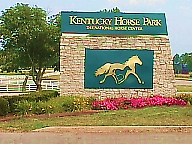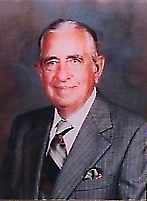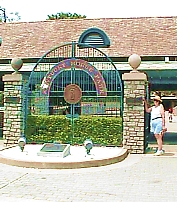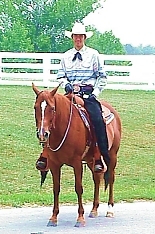The Kentucky
Horse Park
4089 Iron
Works Parkway
Lexington
Ky. 40511
July 13th, 1999
Our first week of full-timing, for the most part, we just rested.
Both inside and outside, our bodies needed repairs from the
grueling experience of moving a 5 bedroom house into a 10X10
storage bin. We had driven into Kentucky just to have a place to
go; to be out of Ohio. Lexington was only a few hours away and
the rolling countryside with its stately horse farms had always
impressed us, although we had never actually stopped there. In
our travels up and down I-75 we had seen the large signs
announcing the "Kentucky Horse Park" and would usually
comment about stopping some day to see what it was all about.
Laura, who is among other things, the camping guide, found that
there is a "Kentucky Horse Park Campgroudn.". Even if you
don't stay there, its worth pulling in to buy the discount
tickets for the Horse Park at the camp store. Normally we do a
little more research than we did on this outing. We visited the
park on Sunday and although the staff was always helpful, getting
the background on the park's creation almost slipped by. As best
as we could determine from those available, the park owes its
existence to one woman. Lucille Caudill, who was born and raised
in Morehead, Kentucky, and schooled at some of the finest
first week of full-timing, for the most part, we just rested.
Both inside and outside, our bodies needed repairs from the
grueling experience of moving a 5 bedroom house into a 10X10
storage bin. We had driven into Kentucky just to have a place to
go; to be out of Ohio. Lexington was only a few hours away and
the rolling countryside with its stately horse farms had always
impressed us, although we had never actually stopped there. In
our travels up and down I-75 we had seen the large signs
announcing the "Kentucky Horse Park" and would usually
comment about stopping some day to see what it was all about.
Laura, who is among other things, the camping guide, found that
there is a "Kentucky Horse Park Campgroudn.". Even if you
don't stay there, its worth pulling in to buy the discount
tickets for the Horse Park at the camp store. Normally we do a
little more research than we did on this outing. We visited the
park on Sunday and although the staff was always helpful, getting
the background on the park's creation almost slipped by. As best
as we could determine from those available, the park owes its
existence to one woman. Lucille Caudill, who was born and raised
in Morehead, Kentucky, and schooled at some of the finest  Universities in
the country, including the prestigious Julliard School of Music
in New York. She gave up her professional career after marrying
W. Paul Little in 1937. Relocating to Lexington, she became a
mover and shaker in the fields of music and drama for the
surrounding area. W. Paul Little was the son of prominent
Lexington Standardbred breeder Ernest R. Little. He received his
introduction to thoroughbred racing while still in his teens.
Encouraged by one of his father's trainers, the young
Universities in
the country, including the prestigious Julliard School of Music
in New York. She gave up her professional career after marrying
W. Paul Little in 1937. Relocating to Lexington, she became a
mover and shaker in the fields of music and drama for the
surrounding area. W. Paul Little was the son of prominent
Lexington Standardbred breeder Ernest R. Little. He received his
introduction to thoroughbred racing while still in his teens.
Encouraged by one of his father's trainers, the young  Little took
a Thoroughbred prompter used to train his father's trotting
horses and turned him into a stakes winner. While involved in
diverse business interests, Mr. Little's passion was always
Thoroughbred horses. Throughout his career, he proved that a
small breeder could successfully compete with the industry's
giants through a combination of shrewd breeding and business
decisions, a thorough knowledge of conformation and bloodlines,
and a love for the horses with which he worked. W. Paul Little's
career spanned six decades. Throughout this period he had
remarkable success arranging pairings which produced top priced
yearling stakes winners and champions. At the 1947 Keenland sales
he and a partner purchased the mare Rocket Gun, which produced
the 1954 Belmont winner High Gun. He would repeat this
performance over and over, building a solid reputation as a
horseman and breeder.
Little took
a Thoroughbred prompter used to train his father's trotting
horses and turned him into a stakes winner. While involved in
diverse business interests, Mr. Little's passion was always
Thoroughbred horses. Throughout his career, he proved that a
small breeder could successfully compete with the industry's
giants through a combination of shrewd breeding and business
decisions, a thorough knowledge of conformation and bloodlines,
and a love for the horses with which he worked. W. Paul Little's
career spanned six decades. Throughout this period he had
remarkable success arranging pairings which produced top priced
yearling stakes winners and champions. At the 1947 Keenland sales
he and a partner purchased the mare Rocket Gun, which produced
the 1954 Belmont winner High Gun. He would repeat this
performance over and over, building a solid reputation as a
horseman and breeder.  One
of his crowning achievements was to join forces with Mrs. H. W.
Nichols, the owner of Walnut Hall Farms to re-organizing the
Lexington Gentleman's Driving Club which presented Standardbred
amateur races, for which Paul Little constantly ranked among its
top riders. After his death in 1990, Mrs. Little, desiring a
tribute to her late husband, created an endowment, funding the
park as a center for education, in his name.
One
of his crowning achievements was to join forces with Mrs. H. W.
Nichols, the owner of Walnut Hall Farms to re-organizing the
Lexington Gentleman's Driving Club which presented Standardbred
amateur races, for which Paul Little constantly ranked among its
top riders. After his death in 1990, Mrs. Little, desiring a
tribute to her late husband, created an endowment, funding the
park as a center for education, in his name.
As we pulled in, the parking lot was as large as a theme parks'.
It was hot, in the upper 90's. I added a generous portion of
suntan lotion. Fluids were no problem. There were several food
stands and numerous pop machines throughout the park. The front
entrance was framed in a large iron works, and although there
were positions for ticket takers, the area
was unmanned. Our tickets would be redeemed on the inside of the
spacious visitors center. The area around the visitors center is
adorned with the life size statues of those famous horses who's
names have become American household words, like Man o' War and
Secretariat. We entered the visitor's center and were directed to
the Breed barn, for the 2:00PM show of the Parade of Breeds. As
we made our way up the hill, we passed by the Farrier's shop and
the Harness shop,
ticket takers, the area
was unmanned. Our tickets would be redeemed on the inside of the
spacious visitors center. The area around the visitors center is
adorned with the life size statues of those famous horses who's
names have become American household words, like Man o' War and
Secretariat. We entered the visitor's center and were directed to
the Breed barn, for the 2:00PM show of the Parade of Breeds. As
we made our way up the hill, we passed by the Farrier's shop and
the Harness shop,  where I paused for a moment to talk to Julann
Spromberg as she explained the workings of the Todd style show
harness for the Belgian horses, which was on display in the shop.
The ring at the Breed Barn was surrounded by covered bleachers,
and gave shelter from the relentlessly beating sun. In the United
States there are more then 150 established
breeds with over 40 breeds represented at the Kentucky Horse
Park. As we rested in the shade, six of the finest horses I had
ever seen were presented. Among them, a Morgan horse, a Quarter
Horse, and a Clydesdale. Each rider was costumed in the attire
matching the horses' history. It was here that we learned about
horse hands. A horse is measured to the highest part of his back,
the withers, in 4 inch units called "Hands". In the old
days a man may have placed his hands one above the other, from
the ground to withers to determine height. As a man's hand is
about 4 inches wide, this measurement was taken as standard.
where I paused for a moment to talk to Julann
Spromberg as she explained the workings of the Todd style show
harness for the Belgian horses, which was on display in the shop.
The ring at the Breed Barn was surrounded by covered bleachers,
and gave shelter from the relentlessly beating sun. In the United
States there are more then 150 established
breeds with over 40 breeds represented at the Kentucky Horse
Park. As we rested in the shade, six of the finest horses I had
ever seen were presented. Among them, a Morgan horse, a Quarter
Horse, and a Clydesdale. Each rider was costumed in the attire
matching the horses' history. It was here that we learned about
horse hands. A horse is measured to the highest part of his back,
the withers, in 4 inch units called "Hands". In the old
days a man may have placed his hands one above the other, from
the ground to withers to determine height. As a man's hand is
about 4 inches wide, this measurement was taken as standard.
 first week of full-timing, for the most part, we just rested.
Both inside and outside, our bodies needed repairs from the
grueling experience of moving a 5 bedroom house into a 10X10
storage bin. We had driven into Kentucky just to have a place to
go; to be out of Ohio. Lexington was only a few hours away and
the rolling countryside with its stately horse farms had always
impressed us, although we had never actually stopped there. In
our travels up and down I-75 we had seen the large signs
announcing the "Kentucky Horse Park" and would usually
comment about stopping some day to see what it was all about.
Laura, who is among other things, the camping guide, found that
there is a "Kentucky Horse Park Campgroudn.". Even if you
don't stay there, its worth pulling in to buy the discount
tickets for the Horse Park at the camp store. Normally we do a
little more research than we did on this outing. We visited the
park on Sunday and although the staff was always helpful, getting
the background on the park's creation almost slipped by. As best
as we could determine from those available, the park owes its
existence to one woman. Lucille Caudill, who was born and raised
in Morehead, Kentucky, and schooled at some of the finest
first week of full-timing, for the most part, we just rested.
Both inside and outside, our bodies needed repairs from the
grueling experience of moving a 5 bedroom house into a 10X10
storage bin. We had driven into Kentucky just to have a place to
go; to be out of Ohio. Lexington was only a few hours away and
the rolling countryside with its stately horse farms had always
impressed us, although we had never actually stopped there. In
our travels up and down I-75 we had seen the large signs
announcing the "Kentucky Horse Park" and would usually
comment about stopping some day to see what it was all about.
Laura, who is among other things, the camping guide, found that
there is a "Kentucky Horse Park Campgroudn.". Even if you
don't stay there, its worth pulling in to buy the discount
tickets for the Horse Park at the camp store. Normally we do a
little more research than we did on this outing. We visited the
park on Sunday and although the staff was always helpful, getting
the background on the park's creation almost slipped by. As best
as we could determine from those available, the park owes its
existence to one woman. Lucille Caudill, who was born and raised
in Morehead, Kentucky, and schooled at some of the finest  Universities in
the country, including the prestigious Julliard School of Music
in New York. She gave up her professional career after marrying
W. Paul Little in 1937. Relocating to Lexington, she became a
mover and shaker in the fields of music and drama for the
surrounding area. W. Paul Little was the son of prominent
Lexington Standardbred breeder Ernest R. Little. He received his
introduction to thoroughbred racing while still in his teens.
Encouraged by one of his father's trainers, the young
Universities in
the country, including the prestigious Julliard School of Music
in New York. She gave up her professional career after marrying
W. Paul Little in 1937. Relocating to Lexington, she became a
mover and shaker in the fields of music and drama for the
surrounding area. W. Paul Little was the son of prominent
Lexington Standardbred breeder Ernest R. Little. He received his
introduction to thoroughbred racing while still in his teens.
Encouraged by one of his father's trainers, the young  Little took
a Thoroughbred prompter used to train his father's trotting
horses and turned him into a stakes winner. While involved in
diverse business interests, Mr. Little's passion was always
Thoroughbred horses. Throughout his career, he proved that a
small breeder could successfully compete with the industry's
giants through a combination of shrewd breeding and business
decisions, a thorough knowledge of conformation and bloodlines,
and a love for the horses with which he worked. W. Paul Little's
career spanned six decades. Throughout this period he had
remarkable success arranging pairings which produced top priced
yearling stakes winners and champions. At the 1947 Keenland sales
he and a partner purchased the mare Rocket Gun, which produced
the 1954 Belmont winner High Gun. He would repeat this
performance over and over, building a solid reputation as a
horseman and breeder.
Little took
a Thoroughbred prompter used to train his father's trotting
horses and turned him into a stakes winner. While involved in
diverse business interests, Mr. Little's passion was always
Thoroughbred horses. Throughout his career, he proved that a
small breeder could successfully compete with the industry's
giants through a combination of shrewd breeding and business
decisions, a thorough knowledge of conformation and bloodlines,
and a love for the horses with which he worked. W. Paul Little's
career spanned six decades. Throughout this period he had
remarkable success arranging pairings which produced top priced
yearling stakes winners and champions. At the 1947 Keenland sales
he and a partner purchased the mare Rocket Gun, which produced
the 1954 Belmont winner High Gun. He would repeat this
performance over and over, building a solid reputation as a
horseman and breeder.  One
of his crowning achievements was to join forces with Mrs. H. W.
Nichols, the owner of Walnut Hall Farms to re-organizing the
Lexington Gentleman's Driving Club which presented Standardbred
amateur races, for which Paul Little constantly ranked among its
top riders. After his death in 1990, Mrs. Little, desiring a
tribute to her late husband, created an endowment, funding the
park as a center for education, in his name.
One
of his crowning achievements was to join forces with Mrs. H. W.
Nichols, the owner of Walnut Hall Farms to re-organizing the
Lexington Gentleman's Driving Club which presented Standardbred
amateur races, for which Paul Little constantly ranked among its
top riders. After his death in 1990, Mrs. Little, desiring a
tribute to her late husband, created an endowment, funding the
park as a center for education, in his name.  ticket takers, the area
was unmanned. Our tickets would be redeemed on the inside of the
spacious visitors center. The area around the visitors center is
adorned with the life size statues of those famous horses who's
names have become American household words, like Man o' War and
Secretariat. We entered the visitor's center and were directed to
the Breed barn, for the 2:00PM show of the Parade of Breeds. As
we made our way up the hill, we passed by the Farrier's shop and
the Harness shop,
ticket takers, the area
was unmanned. Our tickets would be redeemed on the inside of the
spacious visitors center. The area around the visitors center is
adorned with the life size statues of those famous horses who's
names have become American household words, like Man o' War and
Secretariat. We entered the visitor's center and were directed to
the Breed barn, for the 2:00PM show of the Parade of Breeds. As
we made our way up the hill, we passed by the Farrier's shop and
the Harness shop,  where I paused for a moment to talk to Julann
Spromberg as she explained the workings of the Todd style show
harness for the Belgian horses, which was on display in the shop.
The ring at the Breed Barn was surrounded by covered bleachers,
and gave shelter from the relentlessly beating sun. In the United
States there are more then 150 established
breeds with over 40 breeds represented at the Kentucky Horse
Park. As we rested in the shade, six of the finest horses I had
ever seen were presented. Among them, a Morgan horse, a Quarter
Horse, and a Clydesdale. Each rider was costumed in the attire
matching the horses' history. It was here that we learned about
horse hands. A horse is measured to the highest part of his back,
the withers, in 4 inch units called "Hands". In the old
days a man may have placed his hands one above the other, from
the ground to withers to determine height. As a man's hand is
about 4 inches wide, this measurement was taken as standard.
where I paused for a moment to talk to Julann
Spromberg as she explained the workings of the Todd style show
harness for the Belgian horses, which was on display in the shop.
The ring at the Breed Barn was surrounded by covered bleachers,
and gave shelter from the relentlessly beating sun. In the United
States there are more then 150 established
breeds with over 40 breeds represented at the Kentucky Horse
Park. As we rested in the shade, six of the finest horses I had
ever seen were presented. Among them, a Morgan horse, a Quarter
Horse, and a Clydesdale. Each rider was costumed in the attire
matching the horses' history. It was here that we learned about
horse hands. A horse is measured to the highest part of his back,
the withers, in 4 inch units called "Hands". In the old
days a man may have placed his hands one above the other, from
the ground to withers to determine height. As a man's hand is
about 4 inches wide, this measurement was taken as standard.  HOME PAGE
Next >>>>>
HOME PAGE
Next >>>>> 